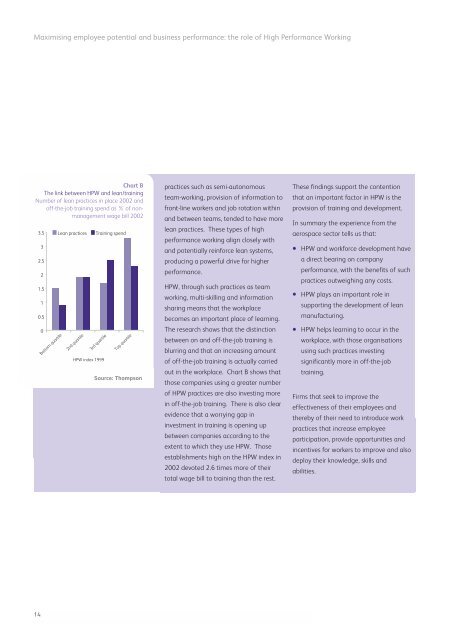Maximising employee potential and business performance: the role of High Performance WorkingBox 2The UK aerospaceexperienceThere are some very relevant andinteresting conclusions from a study ofthe UK aerospace industry (Thompson)that takes a unique approach by usinglongitudinal panel data onestablishments which allows anexploration of performance effects ofHPW. It paints a picture of slow butsteady diffusion of HPW in the aerospaceindustry and there is further evidencethat HPW is related to companyperformance.The study looks at the relationshipbetween an HPW index and companyperformance. The index looks at use ofthree distinct but related groups ofpractices:1. High involvement practices, whichcreate greater opportunities for employeeinvolvement such as: semi-autonomousteam working, continuous improvementteams, responsibility for own work quality,job rotation, information sharingprogrammes and briefing groups.2. Human resource practices, which helpbuild skills levels, motivation and abilitysuch as: appraisal, personal developmentplans, performance based rewards, highlevels of on and off-the-job training,sophisticated recruitment techniques andbroad job grading structures.3. Employee relations practices, whichcan help build trust, loyalty and identitywith the organisation and include:harmonised terms and conditions ofemployment, formal grievanceprocedures, induction programmes, jointconsultative committees, regular socialgatherings, same canteen and eatingarrangements.Over the 1997 – 2002 period a strongand positive relationship was foundbetween the HPW index and sales andvalue-added per employee. Those scoringhigh on HPW in 1997 had average salesin 2002 of £133,000 per employee,compared with £67,000 for those scoringlow on the index. The pattern between1999 and 2002 is even more marked andis summarised in chart A. It shows thatthose establishments in the top quartileon the HPW index in 1999 recorded salesper employee in 2002 of £162,000,compared to £62,000 for those in thebottom quartile – a difference of 161%.Further analysis that looked at the role ofindividual practices found that givingpeople a stake in the business wasparticularly effective at boostingperformance. Use of profit sharing andshare ownership schemes in 1997correlated with higher sales per employeeand higher value-added per employee in2002. It was also found that greaterprovision of information to employees –e.g. briefing groups – was associated withhigher levels of profit per employee. Staffturnover was lower where firms gaveChart AHPW and business performance in aerospaceHow companies scored on HPW in 1999 &VA/Sales per employee in 2002£000s180160140120100806040200Bottom quartileVA per employee2nd quartile3rd quartileHPW index 1999Sales per employeeTop quartileSource: Thompsonemployees more responsibility for thequality of their own work. The authormakes it clear that while these individualpractices are important, they should beseen as a part of a wider, more integratedset of practices that constitute HPW.The results also show a link between theuse of HPW and lean manufacturing.Chart B shows that those firms with agreater number of high performancepractices in 1999 also had more leansystems in place in 2002. In 2002 thosehigh on the index used 3.3 lean systemswhereas those low on the index used 1.5.Companies with a greater number of13
Maximising employee potential and business performance: the role of High Performance WorkingChart BThe link between HPW and lean/trainingNumber of lean practices in place 2002 andoff-the-job training spend as % of nonmanagementwage bill 20023.5 Lean practices Training spend32.521.510.50Bottom quartile2nd quartile3rd quartileHPW index 1999Top quartileSource: Thompsonpractices such as semi-autonomousteam-working, provision of information tofront-line workers and job rotation withinand between teams, tended to have morelean practices. These types of highperformance working align closely withand potentially reinforce lean systems,producing a powerful drive for higherperformance.HPW, through such practices as teamworking, multi-skilling and informationsharing means that the workplacebecomes an important place of learning.The research shows that the distinctionbetween on and off-the-job training isblurring and that an increasing amountof off-the-job training is actually carriedout in the workplace. Chart B shows thatthose companies using a greater numberof HPW practices are also investing morein off-the-job training. There is also clearevidence that a worrying gap ininvestment in training is opening upbetween companies according to theextent to which they use HPW. Thoseestablishments high on the HPW index in2002 devoted 2.6 times more of theirtotal wage bill to training than the rest.These findings support the contentionthat an important factor in HPW is theprovision of training and development.In summary the experience from theaerospace sector tells us that:• HPW and workforce development havea direct bearing on companyperformance, with the benefits of suchpractices outweighing any costs.• HPW plays an important role insupporting the development of leanmanufacturing.• HPW helps learning to occur in theworkplace, with those organisationsusing such practices investingsignificantly more in off-the-jobtraining.Firms that seek to improve theeffectiveness of their employees andthereby of their need to introduce workpractices that increase employeeparticipation, provide opportunities andincentives for workers to improve and alsodeploy their knowledge, skills andabilities.14
















